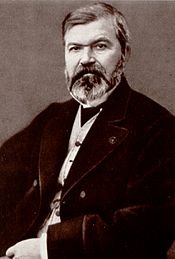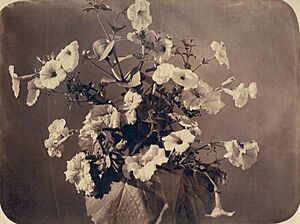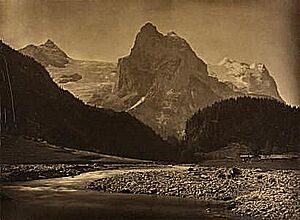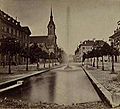Adolphe Braun facts for kids
Jean Adolphe Braun (born June 13, 1812 – died December 31, 1877) was a famous French photographer. He was known for his beautiful pictures of flowers, busy streets in Paris, and amazing mountain views in the Alps.
He was one of the most important French photographers of his time. He used new photography ideas to share his pictures all over the world.
Later in his life, he took photos of famous artworks. This helped people learn more about art history.
Contents
Adolphe Braun's Life Story
Braun was born in Besançon in 1812. He was the oldest child of Samuel Braun, a police officer. When he was about 10, his family moved to Mulhouse. This was a city known for making textiles (fabrics) in the Alsace region.
Adolphe was good at drawing. In 1828, he went to Paris to study decorative design. In 1834, he married Louis Marie Danet. They had three children together. Adolphe and his brother Charles started a design business.
Early Career and Family
After trying different design businesses, Adolphe published a successful collection of flower designs in 1842. Sadly, his wife died in 1843. Braun then sold his studio in Paris. He moved back to Mulhouse.
There, he became the main designer for a company called Dollfus-Ausset. This company made patterns for fabrics. On December 12, 1843, he married Pauline Melanie Petronille Baumann. They had two more children.
In 1847, Braun opened his own design studio. It was in Dornach, a town near Mulhouse.
How He Started Photography
In the early 1850s, Braun started taking pictures of flowers. He used these photos to help him create new flower patterns for fabrics. He used a new method called the collodion process. This allowed him to print many copies from glass plates.
In 1855, he published over 300 of his flower photos in an album called Fleurs photographiées (Photographed Flowers). These photos became very popular in Paris. Braun even showed more of his photos at the Paris Universal Exposition that same year.
Building His Photography Business
In 1857, Braun started a photography company called Braun et Cie. His sons, Henri and Gaston, helped him. They took many photos of the countryside in Alsace. These pictures were put into a book called L’Alsace photographiée in 1859. Some were also shown at the 1859 Salon, a famous art show.
By the 1860s, Braun et Cie was like a factory. They made almost all their own photography materials. The company created thousands of stereoscopic images. These are special photos that look 3D when you view them with a stereoscope. They took pictures of the Alps in France, Germany, Switzerland, and Italy.
Braun also made large, wide photos of the Alps. He used a special camera for these panoramic pictures.
Photographing Artworks
In the mid-1860s, Braun started using a new printing method called carbon print. This method was developed by an English chemist. In 1867, Braun used this new method for a series of large hunting scenes.
He also used the carbon print method to photograph famous artworks. He took pictures of paintings and sculptures in places like the Louvre museum in Paris, the Vatican, and the Albertina museum. This idea was very successful. For the rest of his career, Braun mainly focused on making copies of artworks.
After Adolphe Braun died in 1877, his son Gaston continued to run the company into the 20th century.
Adolphe Braun's Works
His Photographs
Historians say Braun's work showed how art and business mixed in the 1800s. His studio helped photography become a big business. It made thousands of unique pictures that were sold all over Europe and North America.
Braun's detailed copies of artworks in museums helped students in North America. This was a big step for the study of art history in the United States.
Braun's first photos were mostly of flowers. He took them to help with his pattern designs. Later, he focused on mountain landscapes, especially lakes and glaciers. Unlike many photographers then, Braun often included people in his scenes.
He was known for being very skilled at arranging his photos. Even though he wasn't famous for portraits, he did take pictures of important people. These included Pope Pius IX and the musician Franz Liszt.
Braun's work has been shown in famous museums. These include the Metropolitan Museum of Art and the J. Paul Getty Museum. His photos of Paris streets and the Alps are often seen in books about photography history.
Photo Albums He Published
- Fleurs photographiées (1855) - Photographed Flowers
- L’Alsace photographiée (1859) - Alsace Photographed
- Vues d'Alsace (1860) - Views of Alsace
- Costumes de Suisse (1869) - Costumes of Switzerland
Gallery
-
Lake Maggiore, Isola Bella (1860s)









